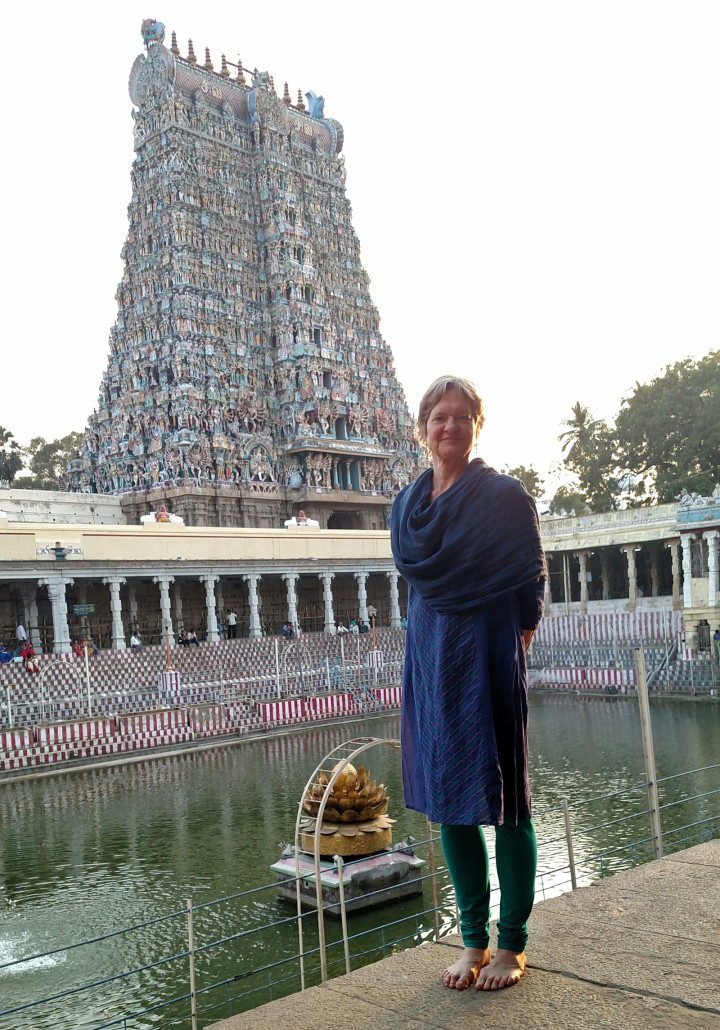
Ellen Saltonstall, Meenakshi Amman Temple, Madurai, India
When I returned from a recent trip to South India, my students asked, “What was the spiritual significance of your trip?” It’s a good question, worthy of ongoing contemplation. We visited 18 temples, ranging from a small outdoor one (just a platform under a tree), to the enormous Meenakshi Amman Temple in Madurai, which covers 45 acres. It was definitely a pilgrimage for me to visit the birthplace of yoga and to feel its strong presence in 21st century life. In particular, we spent a fabulous day at the Nataraj Temple in Chidambaram, which I’ll describe later.
I’ve been a meditator and student of yoga for over 40 years. If you think yoga is just an exercise class, you’re missing out on a huge range of practices and traditions. I began meditating in 1974 within the non-dual Shaivite branch of Hindu yoga, that is, centering on Shiva, one of the Hindu deities. Shiva, Vishnu, Lakshmi, Minakshi, Ganesh – these deities and others are all representatives of cosmic functions and human qualities. Hinduism is generous in saying that you can align with any of the deities that appeals to you, since they all represent aspects of the highest truth. Each temple we visited had dozens of depictions of these deities in sandstone, granite, wood, and paintings. They become like familiar friends after a very short time.
The underlying teaching of Hindu non-dual philosophy: Everything is comprised of the same consciousness in different forms. The highest reality, the Absolute, is not separate from the concrete reality that we experience in daily life – it is interwoven through it. In other words, all life is sacred, and we can connect with that sacredness in our everyday world.
My experiences in the temples we visited made that very clear. In the active temples, devotees were streaming in and out, participating fully in whatever was going on. Rituals that have been performed for centuries are maintained and offered for anyone to witness and participate in. Far from being just about the performance of a task, the authenticity of these rituals is palpable.
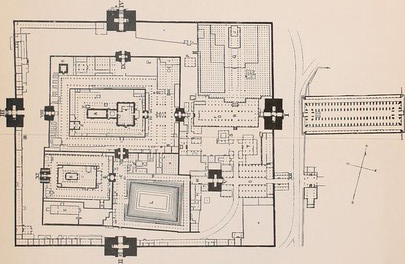
Plan of Meenakshi Amman Temple Madurai, India.
I love that Hindu temples are designed to mirror the layers of the human body. Put your western anatomical thinking aside for the moment, and consider this: We each are made of five concentric sheaths, or layers of being, called koshas. The outermost layer is the sheath of food, the physical body. Next is the more subtle sheath of breath, followed by the still more subtle sheath of thinking, followed by the sheath of understanding. The most subtle and central core sheath is of bliss, in which we revel in our own being in the most profound way. We practice yoga to traverse gradually and systematically through these koshas.
The temples are constructed in concentric courtyards to represent these sheaths. The first entrance and courtyard have the bustle of regular life, but as you get closer to the central area, there’s a strong feeling of vibrating stillness, like what we can experience in meditation. The inner sanctum is often dark and partially hidden, pulling us in like a magnet.
The Nataraj Temple in Chidambaram was the main focus of my pilgrimage; I had heard about it for years, and it was thrilling to be there. Its history goes back to the second century BCE and, among Shiva devotees, it is the pinnacle of sacred places.
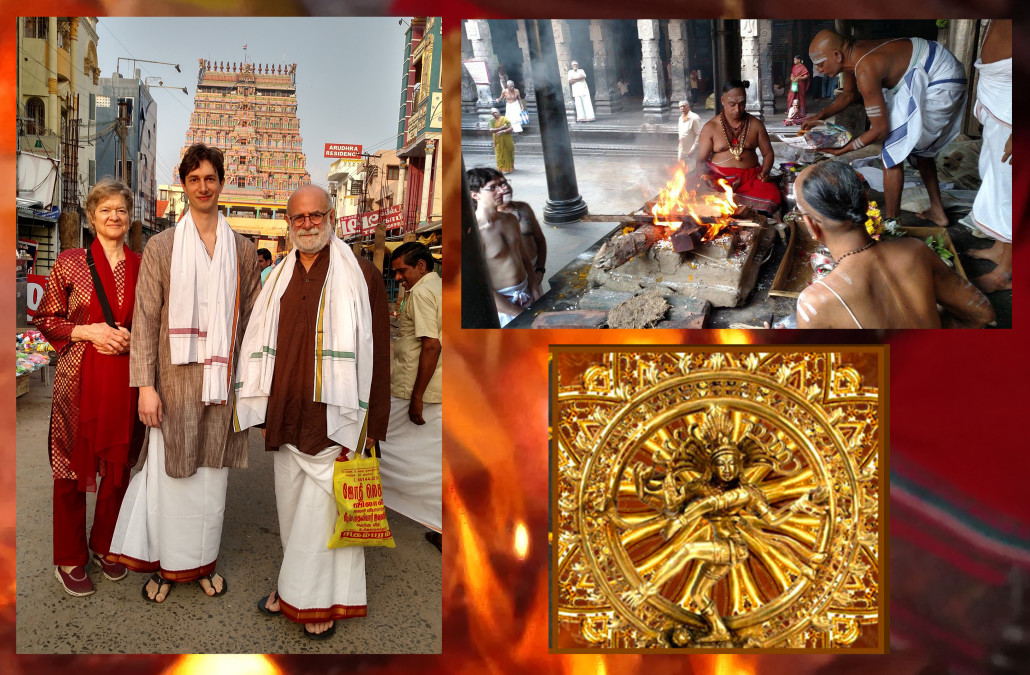
At Chidambaram Temple. (clockwise, left to right): Ellen and family; Fire ceremony; Nataraj.
Nataraj is the name given to the form of Shiva dancing the cosmos into creation. He has four arms and two legs, and each limb is performing a cosmic function: creation, sustenance, destruction, concealment, and revelation. The temple’s architecture has correspondences to the human body: the golden roof over the inner sanctum is made of the same number of tiles as the number of breaths we take every day. The central shrine can be entered from two sides, symbolizing the flow of blood in and out of the heart. The outer walls of the temple have nine entrances, corresponding to the orifices of the human body. The iconography on the major towers (gopurams) depicts the 108 dance forms of Bharanatyam. Honoring the sanctity of the human body is built right into the temple.
This temple, covering 35 acres of land, is cared for by a democratic and hereditary group of 300-400 priests who perform all the rituals and attend to visitors to the temple. We had one priest as our host, a charismatic man with a dynamic energy and huge heart. He guided us through our day there with great generosity and compassion. We watched many ceremonies, and I was particularly mesmerized by the chanting of mantras and sacred texts. Sometimes I could recognize words and could chant along, and other times I just bathed in the sound. It felt both very exotic and also very familiar, as if I had been here before. It also felt nourishing at a very deep level. After each ritual, the priest would say: “Happy?” And I was. The chanting had a purifying effect, burning away the dross of mundane distractions and worries to reveal a wellspring of underlying joy. What a gift! Seeing the practices of yoga in their historical context of these south Indian temples gave me a potent reminder of the power and diversity of this path, for which I’m profoundly grateful.
Join me on March 5 & 6 for the Bodymind Ballwork Workshop where we use we use rubber balls of varying sizes and textures (as small as a walnut and as big as a melon) to support, massage and stretch localized areas of the body. Experience a positive mental and physical shift!
Look for Anatomy for Yoga Teachers and Students and Bodymind Ballwork, two new titles by Ellen Saltonstall to be published in 2016.
_______
Photo credits:
Plan of Meenakshi Amman Temple, Madurai, India : https://en.wiki2.org/wiki/Meenakshi_Amman_Temple
Image of Naturaj figurine: http://www.chidambaramnataraja.org
All other photos by Ellen Saltonstall
Share the post "Visiting the Hindu Temples of South India: The Source of Yoga"
 “Make new friends, but keep the old. One is silver and the other gold.”
“Make new friends, but keep the old. One is silver and the other gold.” 
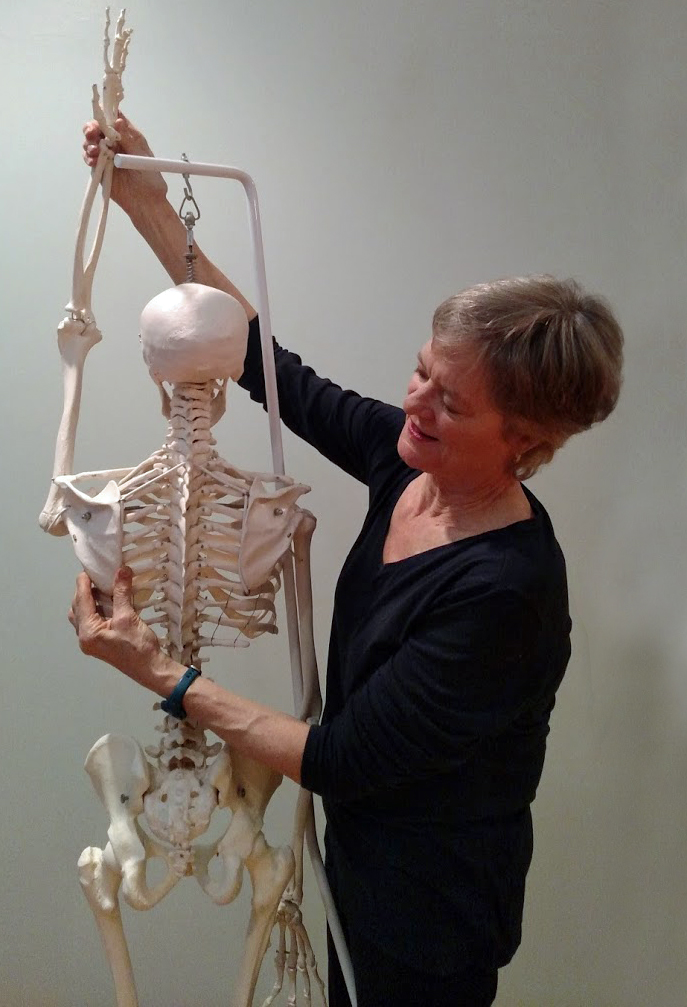 All yoga is inherently therapeutic, so what exactly is yoga therapy as distinct from yoga in general? I’ve heard many great teachers define it in different ways. To me, what makes the distinction is in the goal and the education/experience of the teacher.
All yoga is inherently therapeutic, so what exactly is yoga therapy as distinct from yoga in general? I’ve heard many great teachers define it in different ways. To me, what makes the distinction is in the goal and the education/experience of the teacher.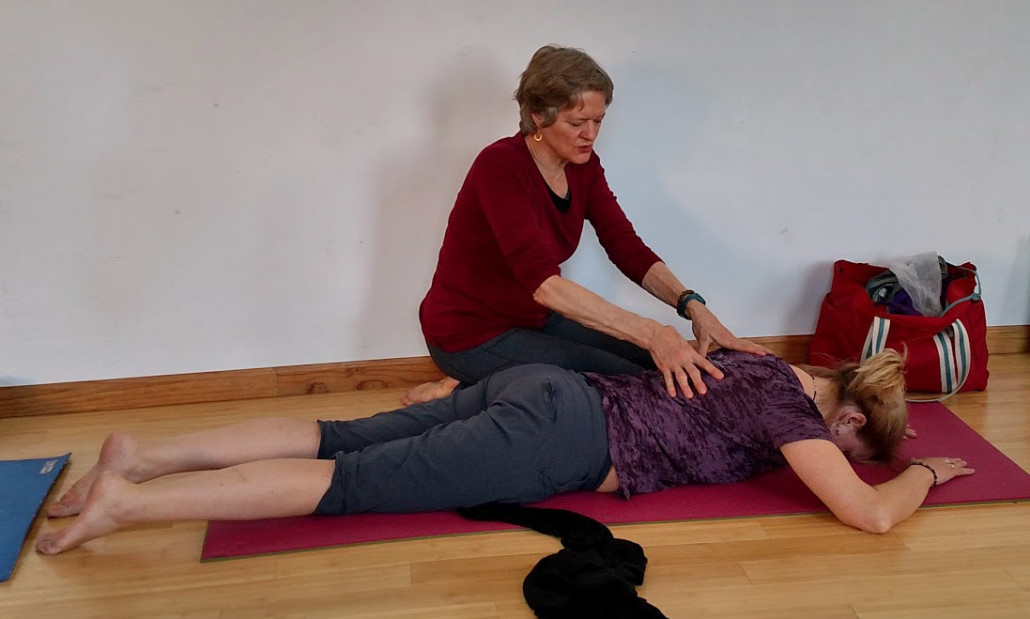 Where can one get this training? Yoga therapy training programs exist around the world, and more will come every year. IAYT has set preliminary standards for training, and this is a good start. We can use the training of psychotherapists, physical therapists and physicians as a model for what’s needed. I advocate a period of formal training (at least two years after completing 500 hours of basic yoga teacher training), followed by a period of supervision/internship, similar to the training of social workers and medical doctors (at least two years). The formal training could be a combination of online and in-person courses, with competency tests. Perhaps those yoga teachers who are also accredited physicians or psychologists could help to design the curriculums and tests based on what has worked in their fields. And these programs should be administered by people who know about yoga. I’d hate to see the training of yoga therapists being legislated by people who know little or nothing about yoga (like university administrators, for instance).
Where can one get this training? Yoga therapy training programs exist around the world, and more will come every year. IAYT has set preliminary standards for training, and this is a good start. We can use the training of psychotherapists, physical therapists and physicians as a model for what’s needed. I advocate a period of formal training (at least two years after completing 500 hours of basic yoga teacher training), followed by a period of supervision/internship, similar to the training of social workers and medical doctors (at least two years). The formal training could be a combination of online and in-person courses, with competency tests. Perhaps those yoga teachers who are also accredited physicians or psychologists could help to design the curriculums and tests based on what has worked in their fields. And these programs should be administered by people who know about yoga. I’d hate to see the training of yoga therapists being legislated by people who know little or nothing about yoga (like university administrators, for instance).


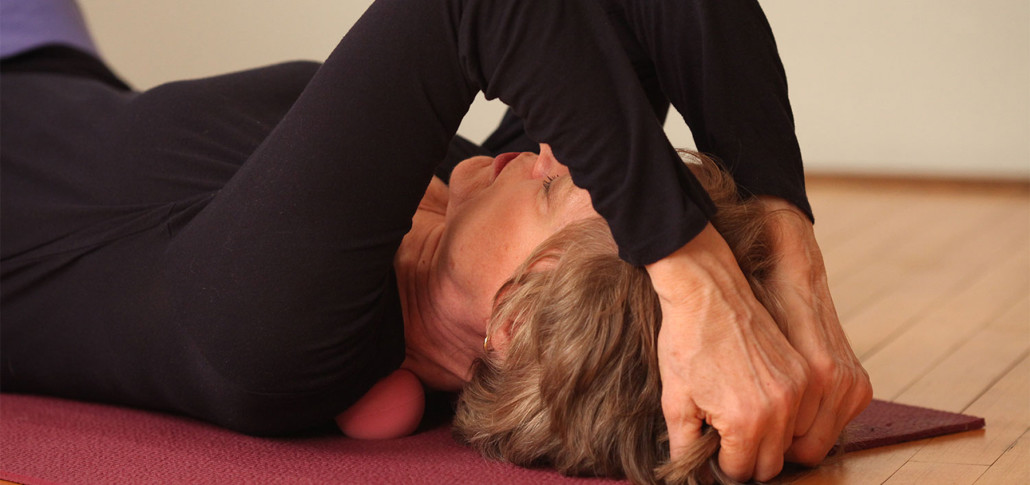
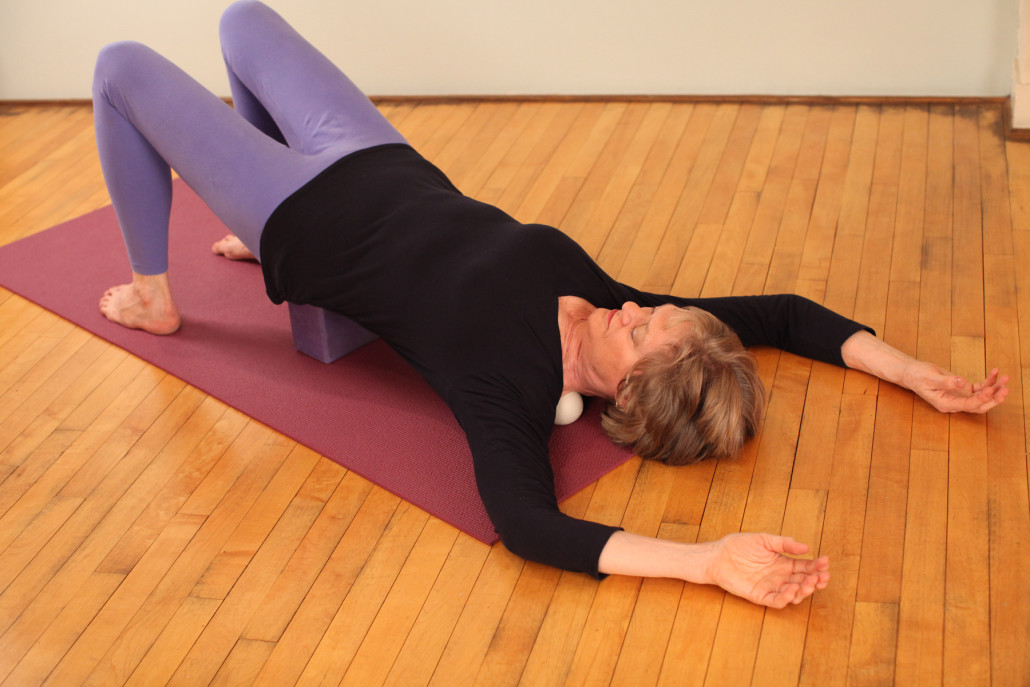 2) Extend your arms overhead, resting your hands on the bolster or on the floor. Settle in this new position, and feel the difference in sensation where the balls are. If they have slipped out of place, just reach back with one hand to reposition them.
2) Extend your arms overhead, resting your hands on the bolster or on the floor. Settle in this new position, and feel the difference in sensation where the balls are. If they have slipped out of place, just reach back with one hand to reposition them.